 |
 |
 |
| |
ATN 110: An HIV PrEP Demonstration Project and Safety Study for Young Men (18-22) who Have (high-risk) Sex with Men in the United States, in 12 cities.....successfully identified & engaged in project
|
| |
| |
(of note in the slide below "HIV Incidence" which depicts the 4 seroconversions the author says in the webcast that at the end of the lines in the graph where the seroconversions occurred there was no drug detectable in the 4 individuals presumably they were no taking drug & that's why they were infected)
Reported by Jules Levin
IAS 2015 Vancouver July 19-23
Sybil Hosek, Bret Rudy, Raphael Landovitz, Bill Kapogiannis, George Siberry, Brandy Rutledge, Nancy Liu, Jennifer Brothers, Jim Rooney, and Craig M. Wilson on behalf of the ATN 110/113 study team.
WEBCAST:
http://pag.ias2015.org/Search/Index
https://www.youtube.com/watch?v=x5uFpMNONqk
http://www.whatisprep.org/ .......in english & spanish
Please note that for women considering PrEP, current evidence suggests that maximum protection can be achieved after about 3-weeks of being on PrEP.
See CDC 2014 Clinical Practice Guidelines at http://www.cdc.gov/hiv/pdf/PrEPguidelines2014.pdf
Program Abstract
An HIV pre-exposure prophylaxis (PrEP) demonstration project and safety study for young men who have sex with men in the United States (ATN 110)
Presented by Sybil Hosek
S. Hosek1, B. Rudy2, R. Landovitz3, B. Kapogiannis4, G. Siberry4, N. Liu5, B. Rutledge5, J. Brothers1, J. Rooney6, C.M. Wilson7, Adolescent Medicine Trials Network for HIV/AIDS Interventions (ATN)
1Stroger Hospital of Cook County, Psychiatry, Chicago, United States, 2New York University Medical Center, New York, United States, 3University of California Los Angeles, Los Angeles, United States, 4NICHD/MPIDB, Bethesda, United States, 5Westat, Rockville, United States, 6Gilead Sciences, Foster City, United States, 7University of Alabama at Birmingham, Birmingham, United States
Background: Young men who have sex with men (YMSM), particularly racial/ethnic minority YMSM, are a key population for implementation of domestic PrEP interventions. This open-label PrEP study examined uptake and adherence to PrEP and assessed sexual risk behavior among a diverse sample of YMSM in 12 US cities.
Methods: ATN110 combined PrEP with evidence-based behavioral risk reduction interventions along with frequent sexual health and adherence promotion counseling. Eligible participants were 18-22 year old HIV-uninfected MSM who reported HIV transmission risk behavior in the past 6 months. Participants were recruited and screened for preliminary eligibility through venue-based outreach, community presentations, and online advertising. Laboratory screening determined final eligibility. Study visits occurred at baseline, monthly through week 12, then quarterly through week 48. Dried blood spots (DBS) were serially collected for the quantification of tenofovir diphosphate (TFV-DP) blood levels.
Results: Between March and September 2013, 2186 individuals were approached, 277 (13%) were preliminarily eligible, and 200 were enrolled (mean age=20.2; 54.5% Black, 26.5% Latino). Eleven (4%) had undiagnosed HIV infection at screening and 2 acute HIV infections were diagnosed at baseline. Diagnosis of STIs at baseline was high (22%) and remained high across visits. Most participants (98%) chose to take PrEP. Figure 1 shows TFV-DP levels. At week 4, 56% of participants had TFV-DP levels consistent with ≥4 pills/week. By week 48, 34% of participants had TFV-DP levels consistent with ≥4 pills/week, with a noticeable drop-off occurring at Week 24. Four HIV seroconversions occurred on study (3.29/100 person-years); all had TFV-DP BLQ at diagnosis. Condomless sex was reported by >80% of participants throughout the study and condomless anal sex with last partner was associated with higher TFV-DP levels.
Conclusions: ATN110 enrolled a diverse sample of YMSM vulnerable to HIV. PrEP uptake was high with the majority achieving protective drug levels during initial monthly visits. As visits decreased in frequency, so did adherence, while reported sexual risk behavior remained constant. Given the frequency of STI diagnoses, HIV infections may have been higher without PrEP. YMSM in the US may need access to PrEP in youth-friendly settings with tailored adherence support and potentially augmented visit schedules.





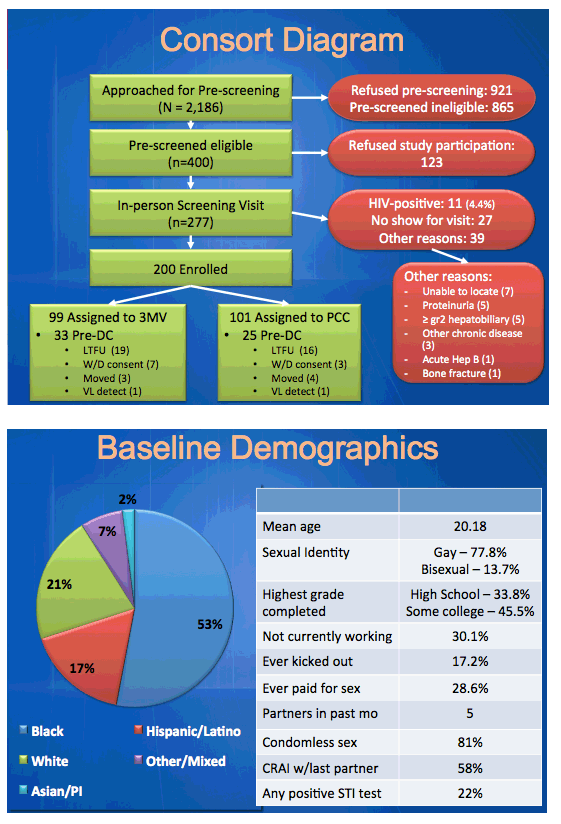
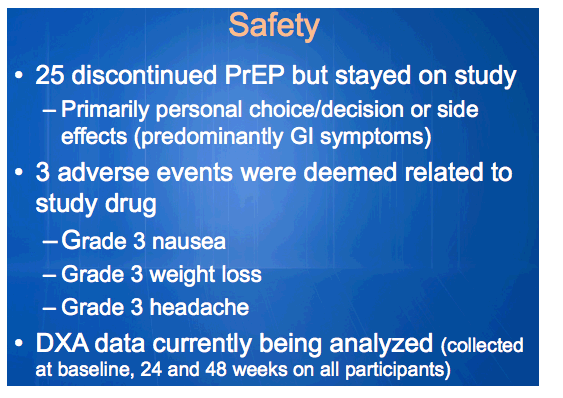
(of note in the slide below "HIV Incidence" which depicts the 4 seroconversions the author says in the webcast that at the end of the lines in the graph where the seroconversions occurred there was no drug detectable in the 4 individuals presumably they were no taking drug & thats why they were infected)
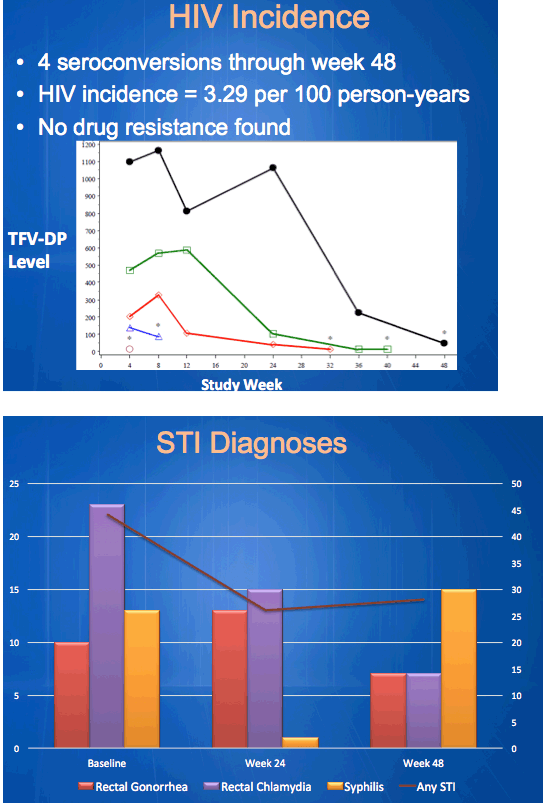
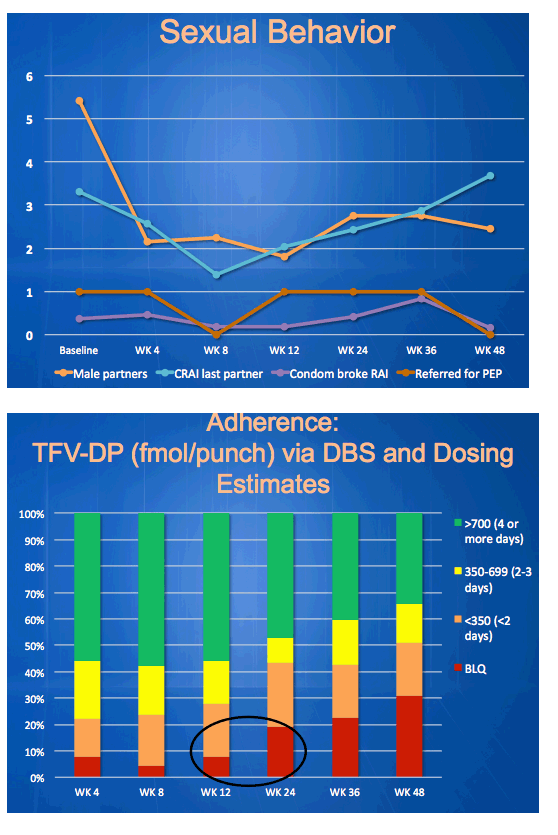

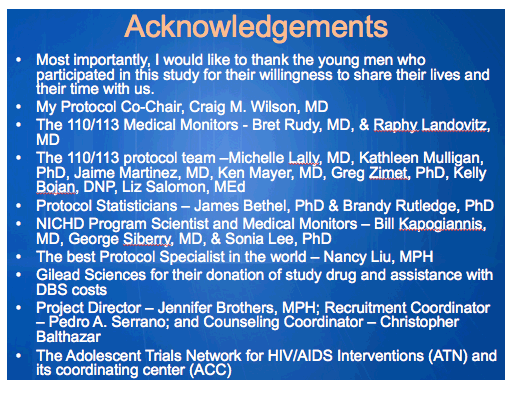
|
| |
|
 |
 |
|
|